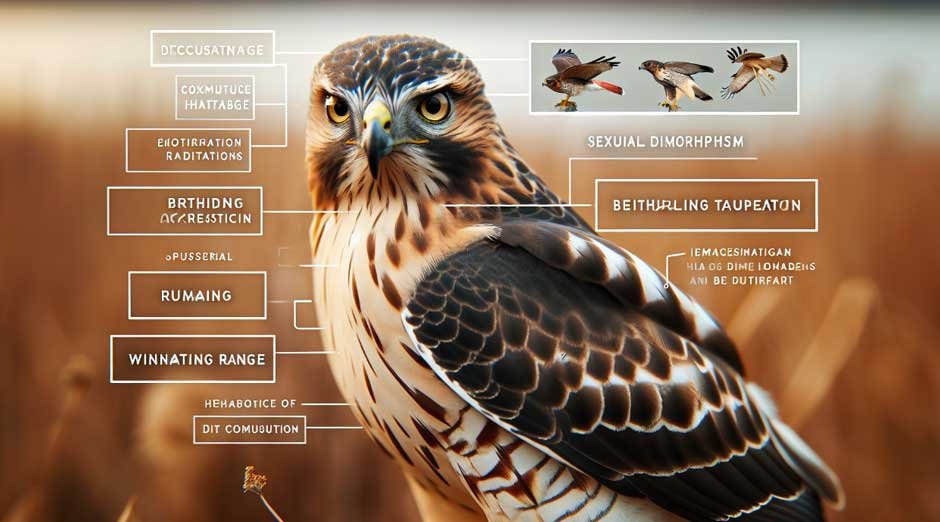Harlan’s Hawk, a unique subspecies of the Red-tailed Hawk, stands as a remarkable testament to the diversity and complexity of avian life. With its distinctive plumage and behaviors, this raptor captures the attention of bird enthusiasts and scientists alike. Understanding the characteristics of Harlan’s Hawk not only enriches our appreciation of nature’s intricacies but also emphasizes the importance of conservation efforts for these magnificent birds. As habitats change and human activities increase, studying and protecting Harlan’s Hawk becomes ever more crucial to preserving biological diversity and ecological balance.
The following sections will delve into the fascinating aspects of Harlan’s Hawk, starting with a detailed description of its appearance, which sets it apart from the more commonly known Red-tailed Hawk. The article will then explore the taxonomy and classification of Harlan’s Hawk, shedding light on its placement within the broader bird family. An examination of its habitat and distribution will highlight the regions where this hawk is found and the environmental preferences that dictate its presence. The behavior and diet of Harlan’s Hawk provide insight into its survival strategies and ecological role. Concluding with a synthesis of key points, this article aims to offer a comprehensive understanding of Harlan’s Hawk, fostering a greater appreciation and awareness among readers.

Description of Harlan’s Hawk
Physical Characteristics
Harlan’s Hawk, a subspecies of the Red-tailed Hawk, exhibits unique physical dimensions that are generally similar to those of the Western Red-tailed Hawk (Buteo jamaicensis calurus). However, it is often described as slighter and lighter. Despite this, there is a significant degree of sexual dimorphism in size, which is the most pronounced among any hawk subspecies in the United States. Mature females of this subspecies can be more massive than almost any female of the B. j. calurus variety. The wing chord of males ranges from 365 to 390 mm, with an average of 381 mm, while in females, it extends from 390 to 430 mm, averaging 408.7 mm. The tail length in males averages 211 mm and 225.3 mm in females. Tarsal length and culmen length also show notable differences between genders, with males measuring 79.8 mm and 24.7 mm, respectively, and females 87 mm and 27 mm.
Sexual Dimorphism
Harlan’s Hawk displays a pronounced sexual dimorphism, which is not only evident in size but also in weight and certain physical features. A wintering female in eastern Kansas, for example, weighed 1,629 grams, showcasing the substantial mass that mature females can achieve. This dimorphism plays a crucial role in the breeding dynamics and survival strategies of the species, as the larger females can dominate larger territories and provide better protection for their offspring.
Plumage Variations
The plumage of Harlan’s Hawk is predominantly blackish, lacking the warmer or brownish tones common in other Red-tailed Hawk subspecies, except on the tail. This hawk typically features faint streaks on the sides of its head and chest, with some gray mottling or speckling on the scapulars. The underparts are mostly black with variable white streaking and barring on the thighs or crissum. Notably, there are up to four main morph variations: the extreme dark morph, where even the throat is black; the dark morph, which retains some barring from the tarsus to the underside; the rare pale morph, which features few blackish blobs on the belly and a generally whiter head; and an even rarer type with a base color that is grayish. These variations contribute to the hawk’s camouflage and adaptability in different environments.
Harlan’s Hawk’s tail is also a distinctive feature, presenting a range of patterns from all white to silvery, banded, or speckled, with varying degrees of red. These tail variations, coupled with the overall plumage patterns, make Harlan’s Hawk a particularly challenging subspecies to identify accurately, especially when considering potential intergradation with the Western Red-tailed Hawk based solely on plumage.
Taxonomy and Classification

Historical Taxonomic Status
The taxonomic history of Harlan’s Hawk has been notably inconsistent. Initially described by John James Audubon in 1831 as Harlan’s Buzzard, named after Dr. Richard Harlan, the bird has oscillated between being classified as its own species, Buteo harlani, and a subspecies of the Red-tailed Hawk, Buteo jamaicensis. The classification has shifted multiple times over the years, influenced by varying interpretations of morphological and genetic data. Notably, R.S. Palmer in 1988 controversially suggested that Harlan’s Hawk was merely a western color morph of the Red-tailed Hawk, a position that few modern authorities support. The species was officially recognized as a distinct species by the American Ornithologists’ Union (AOU) in 1944, only to be reclassified as a subspecies in 1973.
Current Classification
Today, Harlan’s Hawk is recognized as a subspecies of the Red-tailed Hawk, Buteo jamaicensis harlani. This classification reflects a consensus based on genetic studies which show low levels of differentiation among the three subspecies of Red-tailed Hawks. These studies indicate significant gene flow among the subspecies, supporting the current taxonomic status. Despite this, the distinct morphological characteristics of Harlan’s Hawk, such as its unique plumage and the extent of feathering on the tarsus, continue to fuel debates among ornithologists. Some experts advocate for reinstating Harlan’s Hawk as a separate species due to these pronounced differences, which are more significant than those typically observed between subspecies of diurnal raptors. The ongoing discussion reflects the dynamic nature of taxonomic classifications in response to evolving scientific evidence.
Habitat and Distribution
Breeding Range
Harlan’s Hawk primarily breeds from central Alaska to northwestern Canada, with a significant concentration of birds found in the Yukon and western Alaska regions. The southernmost limit of their breeding range extends to north-central British Columbia. This hawk is notably restricted to pure taiga habitats during the breeding season, favoring the dense coniferous forests typical of this biome.
Wintering Range
During the winter months, Harlan’s Hawk migrates to a range that spans from Nebraska and Kansas to Texas and northern Louisiana. Occasionally, individuals are spotted as far east as Tennessee. This wintering range underscores the hawk’s adaptability to various landscapes, although it remains uncommon throughout these areas.
Preferred Habitats
Harlan’s Hawk inhabits a diverse array of environments, though it shows a strong preference for open country and areas that provide both high perches and open ground for hunting. This includes woodlands, prairie groves, mountains, plains, and roadsides. The availability of scattered clearings within woodlands or minimal tree coverage in grasslands and deserts is crucial for their hunting practices. This adaptability to various terrains makes Harlan’s Hawk a widespread and familiar sight across North America, particularly visible along roadside poles or soaring over fields.
Behavior and Diet
Hunting Techniques
Harlan’s Hawk employs a variety of hunting methods, primarily utilizing a high perch strategy. From these elevated vantage points, the hawk observes its surroundings and swoops down to capture prey with its talons. This method allows for efficient energy use and a high success rate due to the element of surprise. Additionally, Harlan’s Hawk is known to hunt by flying over fields, diligently watching for prey below. This technique demonstrates the hawk’s adaptability to different hunting environments and its keen eyesight.
Nesting Behavior
The nesting sites of Harlan’s Hawk are notably diverse, reflecting its adaptability to various environments. Commonly, nests are located in trees, often positioned up to 120 feet above the ground, with the chosen tree typically taller than its surroundings. However, Harlan’s Hawk also utilizes cliff ledges, giant cacti, and even man-made structures like towers or buildings for nesting. These nests are constructed by both sexes, comprising a bulky bowl of sticks lined with finer materials and occasionally adorned with leafy green branches. This variability in nest site selection is indicative of the species’ wide range of habitat tolerance.
Diet Composition
The diet of Harlan’s Hawk is extensive and varied, largely influenced by geographic location and seasonal availability. It primarily feeds on small to medium-sized mammals such as voles, rats, rabbits, and ground squirrels. Birds up to the size of pheasants, as well as reptiles, particularly snakes, also constitute a significant portion of its diet. In some instances, Harlan’s Hawk may consume bats, frogs, toads, insects, and other small creatures, and it does not shy away from scavenging carrion when the opportunity arises. This diverse diet helps the hawk to thrive in a broad range of environments and conditions.
Conclusion
Throughout this exploration of Harlan’s Hawk, we have unraveled its distinctive characteristics, from physical dimensions and plumage variations to its unique behaviors in hunting and nesting. These insights not only augment our understanding of this remarkable subspecies but also highlight the importance of continued observation and conservation efforts. The ongoing debate over its taxonomic classification reflects the complexity of avian biodiversity and the necessity for rigorous scientific inquiry to inform our understanding and protection strategies for such species.
As we consider the broader implications of our study on Harlan’s Hawk, it becomes evident that our fascination with and commitment to these creatures play a crucial role in the stewardship of our planet’s ecological balance. By deepening our appreciation for Harlan’s Hawk, we foster a greater awareness of the myriad challenges facing avian species and their habitats. This awareness, in turn, compels us to advocate for and participate in the conservation initiatives vital for ensuring the survival and thrival of avian diversity across the globe, echoing a call to action for all who cherish the natural world.
FAQs
1. How can you distinguish a Harlan’s hawk?
Harlan’s hawk, particularly the adult dark morph, can be identified by its chocolatey-brown underside, lightly barred whitish flight feathers, dark wing tips, and edges. It also features a mostly whitish tail with a dark tip.
2. What are three fascinating facts about hawks?
Hawks hold a significant place in Native American cultures, admired for their exceptional vision and ability to soar at high altitudes. The red-tailed hawk typically weighs around three pounds, with females being about 25% heavier than males. While they usually fly at speeds of 20-40 mph, they can dive at speeds up to 120 mph.
3. What behaviors are typical of hawks?
Hawks may exhibit aggressive postures by leveling their bodies close to the ground, drooping their wings, and raising the feathers on their heads, necks, and backs. Known for their agility in flight, hawks can also pursue prey on the ground, running and hopping to capture their target.
4. What specific behaviors are associated with red-tailed hawks?
Red-tailed hawks are highly territorial and often mate for life, maintaining the same territory for years, which ranges from half a square mile to two square miles. The male patrols the territory for intruders, while the female aggressively guards their nesting site.
